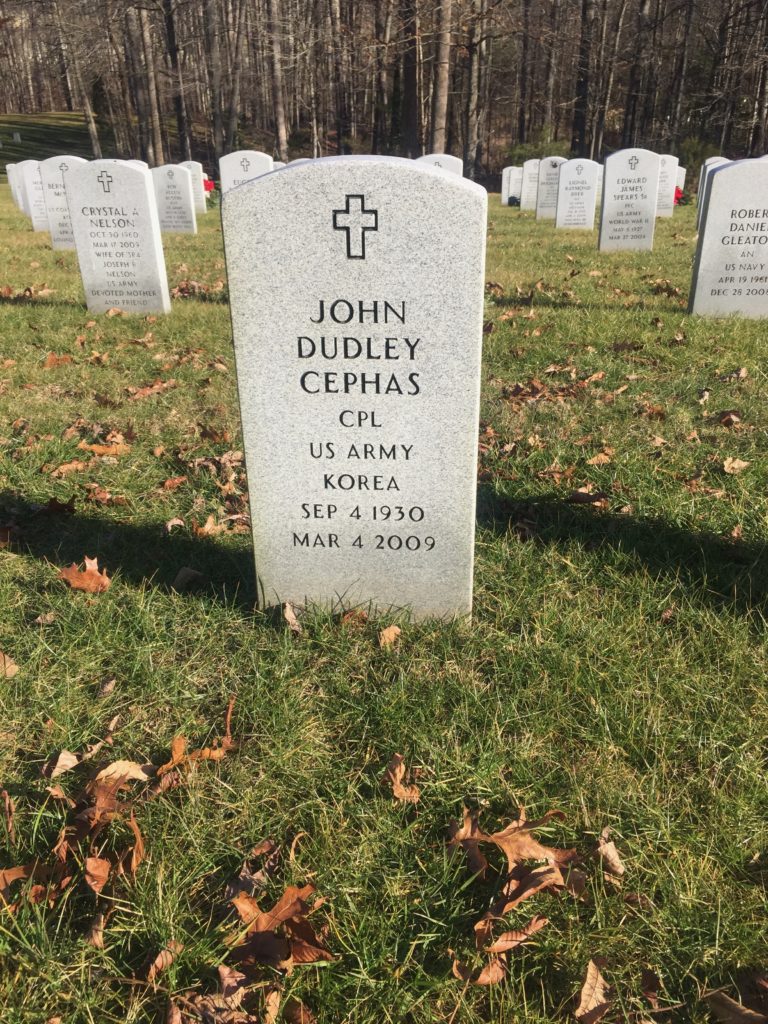Erik Visits an American Grave, Part 995
This is the grave of John Cephas.

Born in 1930 in Washington, D.C., Cephas grew up in Bowling Green, Virginia. His father was a Baptist minister so he grew up singing in the church, as did so many musicians. His parents weren’t real thrilled about his interest in the blues–this was seen by many religious folks as the devil’s music, but they tolerated it and were glad he was interested in music generally. Cephas served in Korea, but we don’t remember him for that. We remember him because he became a master of the Piedmont blues, which while never as popular as the Delta blues or the Chicago blues, was a significant subgenre of the form, one that focused heavily on the fingerpicked guitar and lilting rhythms. Think of the most famous Piedmont players–Brownie McGhee and Sonny Terry. Cephas was a guitar player and singer with a rich baritone. He also played his guitar like a banjo, demonstrating the deep influence of African traditions on the Piedmont blues. He played in a lot of different bands, but he was just a guy. That meant, like most musicians, that he was working whatever jobs and playing his music, hoping to someday make it big enough that he didn’t have to work those jobs. Mostly, he worked as a carpenter at the U.S. Armory. It paid the bills.
In 1976, Cephas got invited to play at one of the Smithsonian folk festivals on the National Mall. There, he met a harmonica player named Phil Wiggins. He was a generation older than Wiggins, but they got along well and started playing together more. They both got hired by Big Chief Ellis to be in his band, which was not a hugely monetary affair, but was certainly a more than respectable blues band. Even Ellis was just running a liquor store in DC to make ends meet.
In 1980, Cephas and Wiggins got the attention of some German blues fans and they were recorded. This gave them greater attention as European fans of the blues now knew who they were. That finally led to some American recordings, first by the great folk label Flying Fish in 1986. This finally got him to the point that he could quit working–he was in his late 50s after all–and live by teaching and playing music. By the early 90s, that’s what he was doing. So good for him. The State Department also hired Cephas and Wiggins to go on some of those goodwill tours, particularly to Africa and Latin America, where they would perform to show the people of the world how great the U.S. is. I’ve always wondered how this was supposed to work as diplomacy, but good for them for making some money and getting to see the world playing music. In 1989, Cephas also received a National Heritage Fellowship from the National Endowment for the Arts. He stated when he won that award:
“When I first started playing, the blues was very popular, but mostly, with the black folk. But then for a time, the type of blues that I play — it kind of died out among black people … because some of the younger people were coming up and they were playing more hip songs, so to speak, jumping songs, upbeat stuff…. The real raw blues just about died out … I think they just got out of touch with that type of blues. There are some young people into it, but very few, very few. It’s mostly white students. They’re more interested in that type of blues. It takes a special type of black man to play that kind of blues today and really feel it. You see, the black man’s blues has a lot of feeling. It’s very profound….”
Cephas died in 2009, at the age of 78. Let’s listen to some of his work:
John Cephas is buried in Quantico National Cemetery, Quantico, Virginia.
If you would like this series to visit other masters of the blues, you can donate to cover the required expenses here. Sonny Boy Williamson is in Tutwiler, Mississippi and Blind Willie McTell is in Thomson, Georgia. Previous posts in this series are archived here.


